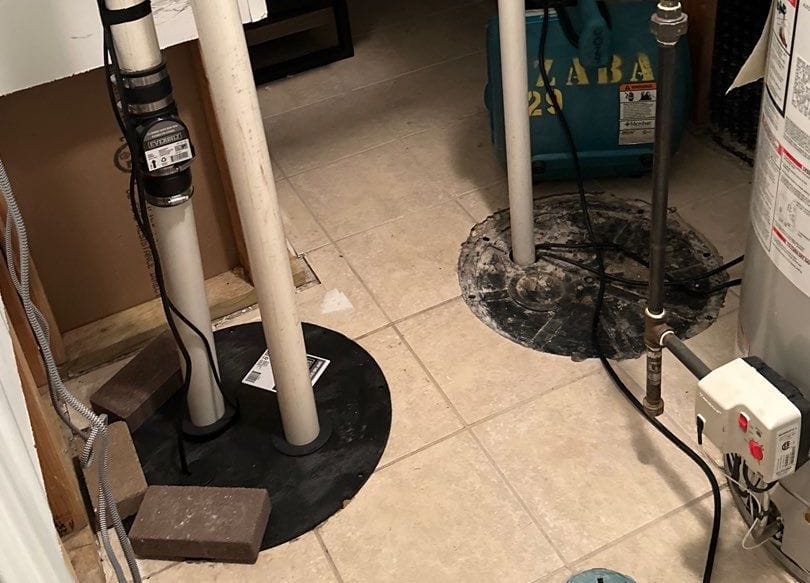If this summer is typical, we’ll get more than 10 inches of rain by the end of August.
That might seem like a lot, but it’s nothing compared to the severe weather and flash flooding that hit Chicago and the suburbs last year.
If you’re like most residents here, you remember where you were that stormy Monday night.
Were you dealing with a flooded basement?
So many of our clients were overwhelmed with basement flooding that we recently posted a list of tips to help everyone prepare for this season’s expected downpours.
We received a lot of great feedback, and many of the questions focused on a simple but important basement appliance.
Have you ever looked down your stairs and wondered, “Do I need a sump pump?” We can help you answer that question.
How Sump Pumps Work

Most sump pumps are about the size of a football and operate on simple mechanics. The pump is positioned in a basin below the basement floor level.
As flood water fills the area, it flows into the basin activating a float on the pump.
The float switches on the pump motor and impeller fan, and the mechanism begins moving water into a drainage pipe.
Your home’s electrical system runs the pump, but it only powers on when water fills the sump basin and causes the float to activate the unit. The pump doesn’t operate during a power outage.
Your backup strategies include battery-powered pumps, portable generators, and units that operate on your home’s water pressure.
Choosing the Right Model
Some models come with sound alarms that go off when the pump fails to function. Others feature a top suction action that helps prevent clogging.
Different manufacturers offer a variety of bells and whistles, but these are your two basic sump pump designs:
-
Pedestal Sump Pump
Because its motor is above the sump basin, this type of pump is easy to service and replace.
It’s an affordable choice, but some homeowners consider it a basement eyesore.
-
Submersible Sump Pump
This unit’s mechanisms are sealed inside the pump to prevent electrical problems, and it handles debris better than a pedestal model.
However, submersibles are usually more expensive.
If you’re an experienced DIY warrior with some plumbing experience, you can install your own sump pump.
Still, it’s a good idea to talk with a professional before deciding on the best pump for your basement.
When Do You Need a Sump Pump?
Stormy weather doesn’t always end with a flooded basement.
However, you don’t want to head downstairs after heavy rains and discover an indoor pool.
If your home meets any of these conditions, you need a sump pump.
- Your basement floor is lower than the surrounding water table.
- The soil around your foundation tends to trap and pool water.
- Your landscape needs grading to improve drainage.
- The house’s foundation needs crack and patch repair inside, out, or both.
- The basement has an exterior entrance, windows, or both.
- The furnace and other appliances are located in the basement.
- You store household belongings downstairs.
- Your home is located in a flood zone or watershed.
- You’ve experienced flooding in the past.
What You Need to Know
Whether you tackle installation yourself or rely on a pro, keep in mind some basic sump pump facts.
The more you know, the better prepared you are to buy the best model for your home.
The following information can also help you maintain and troubleshoot your sump pump.
- Don’t judge a pump by its horsepower. You want a model with as much pumping volume as you can afford. Determine how many gallons per hour a pump can handle from information on the manufacturer’s website.
- If you have a large basement, consider installing multiple pumps. The extra investment can minimize basement flooding and water damage cleanup.
- Energy-efficient pumps live longer mechanical lives. Their low amperage allows them to run cooler than other models, and that keeps the float and motor from overheating and burning out.
- Invest in quality equipment. The best sump pumps feature UL-rated motors, vertical or caged float switches, and cast aluminum, cast iron, or stainless steel construction.
- The only way to confirm proper operation is by testing the pump. Make this a routine so that you can minimize the chances of dealing with a flooded basement.
- If the pump or float shifts inside its housing, the unit can’t operate properly. Check it regularly to make sure that it’s properly seated in the basin and clear of any debris.
Here for You Rain or Shine

If your home already has a sump pump, we hope that our post gives you a better overview of this important appliance and how it prevents flooded basement cleanup headaches.
If you’re ready to install your first pump and need a little more help, we’re happy to answer your questions through our comments section.
We’re here for you rain or shine, and we enjoy sharing information that we know you can put to good use.
In our experience, most sump pumps do a good job, but like all mechanical devices issues can come up. Our experts help you out with DIY tips in this blog article.
If all else fails, know that you can always count on us for flooded basement cleanup in Chicago and the suburbs. ServiceMaster Restoration by Zaba stands ready to answer your call 24/7.